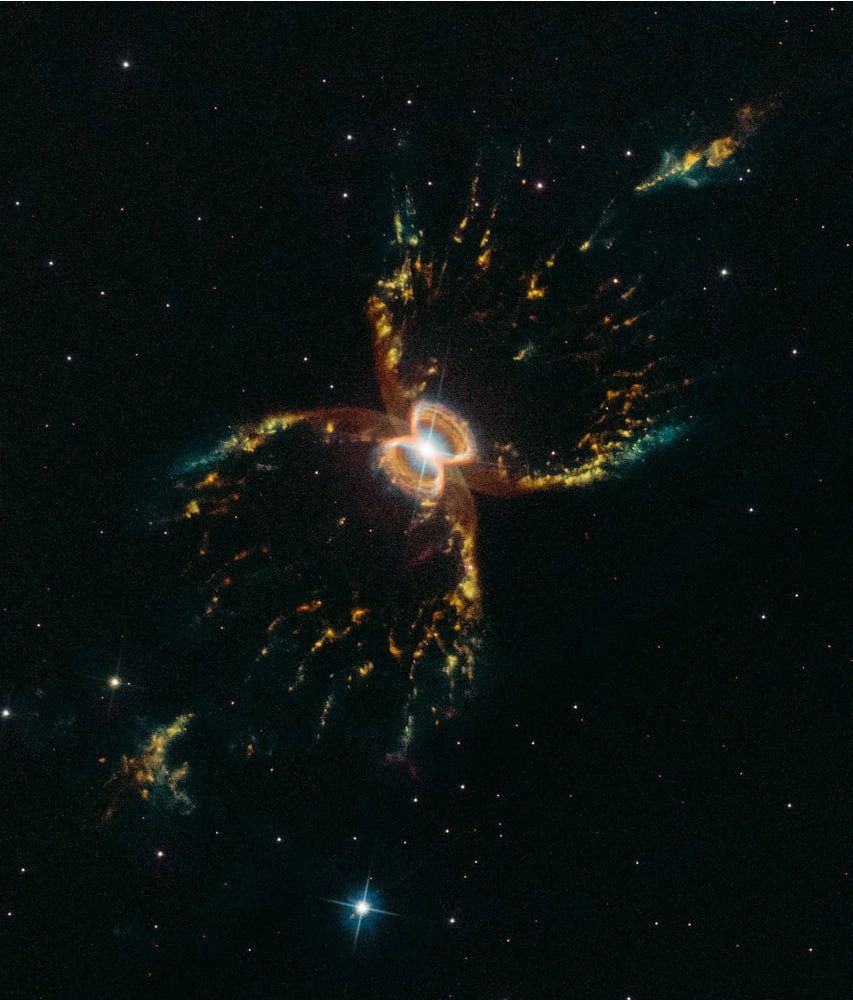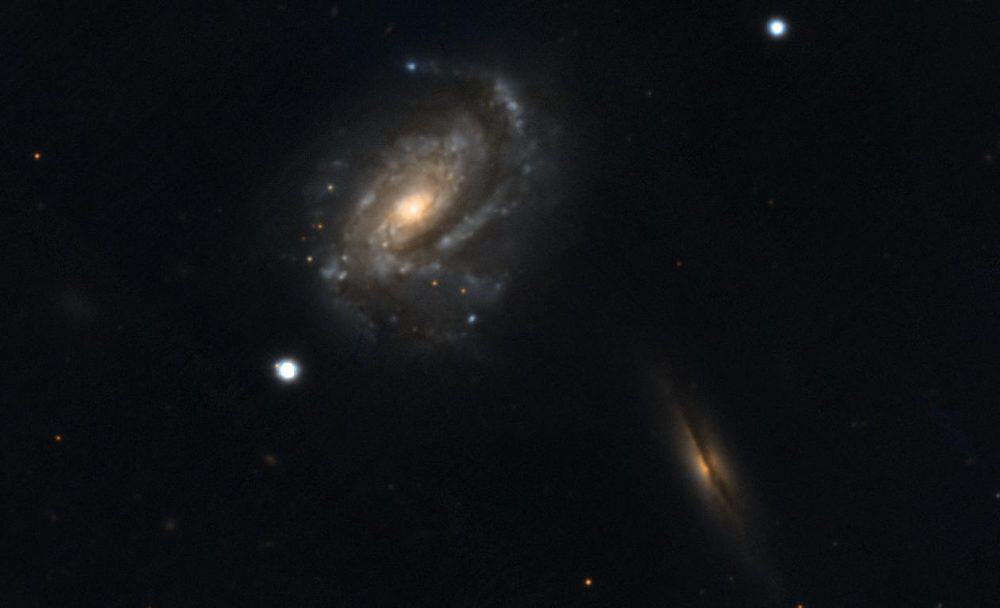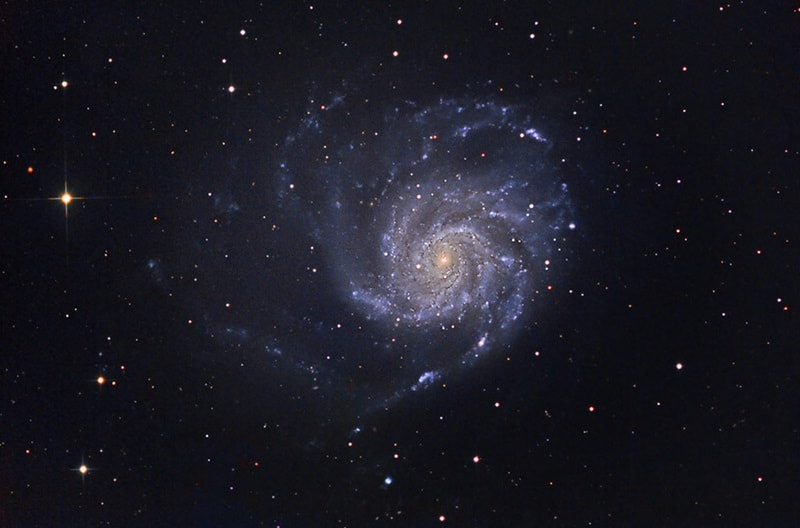Blog
The symmetric, multi-legged appearance of the Southern Crab Nebula is certainly distinctive. About 7,000 light-years distant toward the southern sky constellation Centaurus, its glowing nested hourglass shapes are produced by the remarkable symbiotic binary star system at its center. The nebula’s dramatic stellar duo consists of a hot white dwarf star and cool, pulsating red giant star shedding outer layers that fall onto the smaller, much hotter companion. Embedded in a disk of material, outbursts from the white dwarf cause an outflow of gas driven away both above and below the disk resulting in the bipolar hourglass shapes. The bright central shape is about half a light-year across. This new Hubble Space Telescope image celebrates the 29th anniversary of Hubble’s launch on April 24, 1990 on board the Space Shuttle Discovery.
more...Joe Henderson (April 24, 1937 – June 30, 2001) was an American jazz tenor saxophonist. In a career spanning more than four decades, Henderson played with many of the leading American players of his day and recorded for several prominent labels, including Blue Note.
Born in Lima, Ohio, Henderson was one of five sisters and nine brothers. He was encouraged by his parents Dennis and Irene (née Farley)and older brother James T. to study music. He dedicated his first album to them “for being so understanding and tolerant” during his formative years. Early musical interests included drums, piano, saxophone and composition. According to Kenny Dorham, two local piano teachers who went to school with Henderson’s brothers and sisters, Richard Patterson and Don Hurless, gave him a knowledge of the piano. He was particularly enamored of his brother’s record collection. It seems that a hometown drummer, John Jarette, advised Henderson to listen to musicians like Lester Young, Stan Getz, Dexter Gordon and Charlie Parker.
more...John Arnold Griffin III (April 24, 1928 – July 25, 2008) was an American jazz tenor saxophonist. Nicknamed “the Little Giant” for his short stature and forceful playing, Griffin’s career began in the early 1940s and continued until the month of his death. A pioneering figure in hard bop, Griffin recorded prolifically as a bandleader in addition to stints with pianist Thelonious Monk, drummer Art Blakey, in partnership with fellow tenor Eddie “Lockjaw” Davis and as a member of the Kenny Clarke/Francy Boland Big Band after he moved to Europe in the 1960s. In 1995, Griffin was awarded an Honorary Doctorate of Music from Berklee College of Music.
Griffin studied music at DuSable High School in Chicago under Walter Dyett, starting out on clarinet before moving on to oboe and then alto sax. While still at high school at the age of 15, Griffin was playing with T-Bone Walker in a band led by Walker’s brother.
Alto saxophone was still his instrument of choice when he joined Lionel Hampton‘s big band three days after his high school graduation, but Hampton encouraged him to take up the tenor, playing alongside Arnett Cobb. He first appeared on a Los Angeles recording with Hampton’s band in 1945 at the age of 17.
more...NGC 877 is an intermediate spiral galaxy located in the constellation Aries. It is located at a distance of circa 160 million light years from Earth, which, given its apparent dimensions, means that NGC 877 is about 115,000 light years across. It was discovered by William Herschel on October 14, 1784. It interacts with NGC 876.
NGC 877 features two spiral arms with a grand design pattern and slightly disturbed morphology. When pictured in H-alpha, the arms have numerous knots and appear brighter than the nucleus. The northwest part of the galaxy has higher polarised emission than the rest of the galaxy. A bar appears in radio waves. The nucleus has activity that resembles that of a HII region. The galaxy has been categorised as a luminous infrared galaxy, a category of galaxies associated with high star formation rate. The total infrared luminosity of the galaxy is estimated to be between 1011.04 L☉ and 1011.1 L☉, lying near the threshold to classify a galaxy as luminous infrared. The total star formation rate in NGC 877 is estimated to be between 20 and 53 M☉ per year.
One possible supernova has been observed in NGC 877, SN 2019rn. It was discovered by the robotic sky survey ATLAS on January 12.30, 2019, using a twin 0.5m telescope system. It had apparent magnitude 18.9 on discovery. The supernova was initially classified as a type II supernova with spectroscopic observations by Keck-II, and further spectographic observations categorised it as type IIb, although it could also be a cataclysmic variable or another type of variable star.
NGC 877 forms a pair with the edge-on spiral galaxy NGC 876, which lies 2.1 arcminutes to the southwest. At the distance of NGC 877, this corresponds to a projected distance of 30 kpc.
more...Roy Kelton Orbison (April 23, 1936 – December 6, 1988) was an American singer, songwriter, and musician known for his powerful voice, wide vocal range, impassioned singing style, complex song structures, and dark, emotional ballads. The combination led many critics to describe his music as operatic, nicknaming him “the Caruso of Rock” and “the Big O”. While most male rock-and-roll performers in the 1950s and 1960s projected a defiant masculinity, many of Orbison’s songs instead conveyed vulnerability. During performances, he was known for standing still and solitary and for wearing black clothes to match his dyed jet-black hair and dark sunglasses; all of this lent an air of mystery to his persona.
Born in Texas, Orbison began singing in a rockabilly and country-and-western band in high school. He was signed by Sam Phillips, of Sun Records, in 1956, but his greatest success came with Monument Records. From 1960 to 1966, 22 of his singles reached the Billboard Top 40, and he wrote or co-wrote almost all that rose to the Top 10, including “Only the Lonely” (1960), “Running Scared” (1961), “Crying” (1961), “In Dreams” (1963), and “Oh, Pretty Woman” (1964). Soon afterward, he was struck by a number of personal tragedies while his record sales declined.
In the 1980s, Orbison experienced a resurgence in popularity following the success of several cover versions of his songs. In 1988, he co-founded the Traveling Wilburys, a rock supergroup, with George Harrison, Bob Dylan, Tom Petty, and Jeff Lynne. Orbison died of a heart attack in December 1988 at the age of 52. One month later, Orbison’s song “You Got It” (1989), co-written with Lynne and Petty, was released as a solo single and became his first hit to reach the U.S. Top 10 in nearly 25 years.
Orbison’s honors include inductions into the Rock and Roll Hall of Fame in 1987, the Nashville Songwriters Hall of Fame in the same year, and the Songwriters Hall of Fame in 1989. Rolling Stone placed him at number 37 on their list of the “Greatest Artists of All Time” and number 13 on their list of the “100 Greatest Singers of All Time’. In 2002, Billboard magazine listed Orbison at number 74 in the Top 600 recording artists.
more...Vernice “Bunky” Green (born April 23, 1935) is an American jazz alto saxophonist and educator.
His first big break came when he was hired in New York City by Charles Mingus as a replacement for Jackie McLean in the 1960s. His brief stint with the eccentric bass player made a deep impression. Mingus’ sparing use of notationand his belief that there was no such thing as a wrong note had a lasting influence on Green’s own style.
The next year, Green moved to Chicago, Illinois, where he appeared with several prominent players including Sonny Stitt, Louie Bellson, Andrew Hill, Yusef Lateef, and Ira Sullivan. Originally strongly influenced by Charlie Parker, Green spent a period reassessing his style and studying, emerging with a highly distinctive sound that has deeply influenced a number of younger saxophonists, including Steve Coleman and Greg Osby.
https://www.youtube.com/watch?v=SQURFbCzDZk
more...Charles Edward “Cow Cow” Davenport (April 23, 1894 – December 3, 1955) was an American boogie-woogie and piano blues player as well as a vaudeville entertainer. He also played the organ and sang.
Davenport, who also made recordings under the pseudonyms of Bat The Humming Bird, George Hamilton and The Georgia Grinder, is a member of the Alabama Music Hall of Fame.
He was born in Anniston, Alabama, United States, one of eight children. Davenport started playing the piano at age 12. His father objected strongly to his musical aspirations and sent him to a theological seminary, where he was expelled for playing ragtime.
Davenport’s career began in the 1920s when he joined Banhoof’s Traveling Carnival, a medicine show. His first fame came as accompanist to blues musicians Dora Carr and Ivy Smith. Davenport and Carr performed as a vaudeville act as “Davenport & Co”, and he performed with Smith as the “Chicago Steppers”. He also performed with Tampa Red. Davenport recorded for many record labels, and was a talent scout and artist for Vocalion Records. Davenport suffered a stroke in 1938 and lost movement in his hands. He was washing dishes when he was found by the jazz pianist Art Hodes. Hodes assisted in his rehabilitation and helped him find new recording contracts.
His best-known tune was “Cow Cow Blues”. The “Cow Cow” in the title referred to a train’s cowcatcher. The popularity of the song gave Davenport the nickname “Cow Cow.” In 1953, “Cow Cow Blues” was an influence on the Ahmet Ertegün-written “Mess Around” by Ray Charles,[citation needed] which was Charles’s first step away from his Nat “King” Cole-esque style, and into the style he would employ throughout the 1950s for Atlantic Records.
https://www.youtube.com/watch?v=D_40mGvLL9k
more...
https://www.youtube.com/watch?v=2RG9qBzHHrQ
more...Spiral galaxy M101 is a giant with a diameter on the order of 170,000 light-years. It lies in the constellation Ursa Major the Great Bear some 23 million light-years away. The Pinwheel Galaxy (also known as Messier 101, M101 or NGC 5457) is a face-on spiral galaxy distanced 21 million light-years (six megaparsecs) away from Earth in the constellation Ursa Major. Discovered by Pierre Méchain on March 27, 1781, it was communicated to Charles Messier who verified its position for inclusion in the Messier Catalogue as one of its final entries.
more...Paul Laurence Dunbar Chambers, Jr. (April 22, 1935 – January 4, 1969) was a jazz double bassist. A fixture of rhythm sections during the 1950s and 1960s, his importance in the development of jazz bass can be measured not only by the extent of his work in this short period, but also by his impeccable timekeeping and intonation, and virtuosic improvisations. He was also known for his bowed solos. Chambers recorded about a dozen albums as a leader or co-leader, and as a sideman, notably as the anchor of trumpeter Miles Davis‘s “first great quintet” (1955–63) and with pianist Wynton Kelly (1963–68).
Lorenzo Aitken (22 April 1927 – 17 July 2005), better known by the stage name Laurel Aitken, was an influential Caribbean singer and one of the pioneers of Jamaican ska music. He is often referred to as the “Godfather of Ska”. Born in Cuba of mixed Cuban and Jamaican descent, Aitken and his family settled in Jamaica in 1938. After an early career working for the Jamaican Tourist Board singing mento songs for visitors arriving at Kingston Harbour, he became a popular nightclub entertainer. His first recordings in the late 1950s were mento tunes such as “Nebuchnezer”, “Sweet Chariot” (aka the gospel classic “Swing Low, Sweet Chariot”) and “Baba Kill Me Goat”. Aitken’s 1958 single “Boogie in My Bones”/”Little Sheila” was one of the first records produced by Chris Blackwell and the first Jamaican popular music record to be released in the United Kingdom. Other more Jamaican rhythm and blues orientated singles from this period include “Low Down Dirty Girl” and “More Whisky” both produced by Duke Reid.
https://www.youtube.com/watch?v=kmI6Ml43Wfw
more...Charles Mingus Jr. (April 22, 1922 – January 5, 1979) was an American jazz double bassist, pianist, composer and bandleader. A major proponent of collective improvisation, he is considered to be one of the greatest jazz musicians and composers in history, with a career spanning three decades and collaborations with other jazz legends such as Louis Armstrong, Duke Ellington, Charlie Parker, Dizzy Gillespie, Dannie Richmond, and Herbie Hancock.
Mingus’ compositions continue to be played by contemporary musicians ranging from the repertory bands Mingus Big Band, Mingus Dynasty, and Mingus Orchestra, to the high school students who play the charts and compete in the Charles Mingus High School Competition. In 1993, The Library of Congress acquired Mingus’s collected papers—including scores, sound recordings, correspondence and photos—in what they described as “the most important acquisition of a manuscript collection relating to jazz in the Library’s history”.
Charles Mingus was born in Nogales, Arizona. His father, Charles Mingus Sr., was a sergeant in the U.S. Army. Mingus was largely raised in the Watts area of Los Angeles. His maternal grandfather was a Chinese British subject from Hong Kong, and his maternal grandmother was an African-American from the southern United States. Mingus was the third great-grandson of the family’s founding patriarch who was, by most accounts, a German immigrant. His ancestors included German American, African American, and Native American.
https://www.youtube.com/watch?v=5STaUWmh9bw
more...More Posts
- World Music with Paco Soto
- Daily Roots with Amy Winehouse
- The Cosmos with RCW 57
- Marcus Miller Day
- Kenny Drew Jr Day
- Junior Walker Day
- World Music with Amadu Bansang Jobarteh
- Daily Roots with Sly & Robbie
- The Cosmos with NGC 6164
- Attila Zoller Day
- Wild Bill Moore Day
- Don Cheatham Day
- World Music with Slonovski Bal
- Daily Roots with Playing for Change
- The Cosmos with NGC 660
- Peter Beets Day
- Chick Corea Day
- World Music with Jacky Molard
- Daily Roots with Steel Pulse
- The Cosmos with GGD 27



